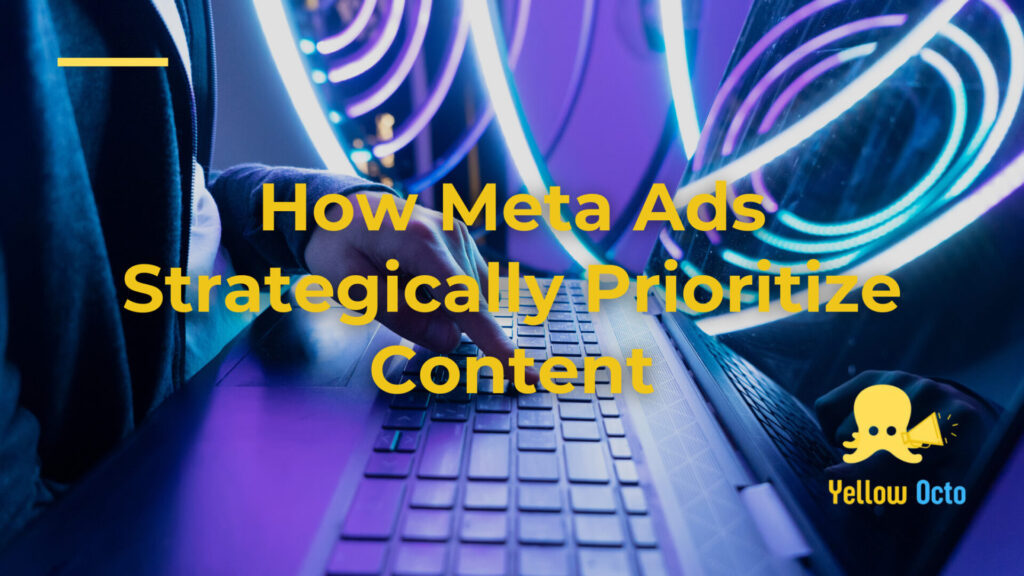How Meta Ads Strategically Prioritize Content
1. Introduction: Understanding the power of optimized content
Performance marketing is an essential component of any successful advertising campaign. As businesses strive to reach their target audience and maximize their return on investment, it is crucial to understand the intricacies of meta ads and how they strategically prioritize content. Meta ads, such as Facebook Ads and Google Ads, have revolutionized the advertising industry by offering sophisticated targeting options and advanced analytics. By delving into the world of performance-based marketing, businesses can enhance their online presence and achieve their marketing goals.
Are your ADs generating ROAS below 3? Schedule a free call with Yellow Octo!
In this blog, we will explore the key elements of meta ads and discuss how they can benefit businesses in the B2B realm. If you are looking to elevate your marketing strategy and work with the best marketing agency in Noida, keep reading to unravel the enigma of meta ads.
2. The significance of prioritizing content in meta advertising
Prioritizing content in meta advertising plays a significant role in the success of an advertising campaign. Meta ads allow businesses to target specific audiences based on their interests, demographics, and online behavior. By strategically prioritizing content, businesses can ensure that their ads are displayed to the most relevant audience, increasing the chances of engagement and conversion.
When creating meta ads, it is important to consider the needs and preferences of the target audience. Understanding their pain points and offering valuable solutions through compelling content can significantly enhance the effectiveness of an advertising campaign. By capturing the attention of the audience with relevant and engaging content, businesses can establish trust and credibility, ultimately leading to increased brand awareness and customer loyalty.
In the next section, we will delve deeper into the various strategies and techniques that can be employed to optimize content prioritization in meta ads. Stay tuned to unlock the secrets of creating impactful and successful meta advertising campaigns.
3. Unveiling the enigma: What are meta ads and their strategic relevance?
In this section, we will begin to unravel the enigma of meta ads and explore their strategic relevance in today’s advertising landscape.
Meta ads, also known as meta-tagged ads or contextual ads, are a form of targeted advertising that utilizes the metadata associated with a website’s content to serve relevant ads to the audience. These ads are designed to align with the interests, preferences, and needs of the target audience, ensuring maximum engagement and conversion rates.
 The strategic relevance of meta ads lies in their ability to reach the right audience at the right time. By analyzing the metadata of a website and matching it with the targeted audience’s profile, businesses can create highly personalized and contextually relevant ads. This targeted approach increases the chances of capturing the audience’s attention and driving them to take desired actions.
The strategic relevance of meta ads lies in their ability to reach the right audience at the right time. By analyzing the metadata of a website and matching it with the targeted audience’s profile, businesses can create highly personalized and contextually relevant ads. This targeted approach increases the chances of capturing the audience’s attention and driving them to take desired actions.
In the upcoming sections, we will delve into the specific tactics and best practices for implementing meta ads effectively. Stay tuned to discover how businesses can leverage the power of meta ads to optimize their content prioritization and achieve their advertising goals.
4. The secrets behind prioritizing content in meta ads
In this section, we will dive deeper into the secrets behind prioritizing content in meta ads. As we discussed earlier, the strategic relevance of meta ads lies in their ability to reach the right audience at the right time. But how do businesses ensure that they prioritize the most relevant content in their ads?
One key factor is understanding the audience’s intent. By analyzing the metadata and keyword data, businesses can gain insights into what their audience is searching for and tailor their content accordingly.This means identifying keywords and phrases that are closely related to the products or services being advertised and incorporating them strategically in the ad copy.
Another crucial aspect is relevance. Ads should not only align with the overall content of the website but also with the specific page or section where they are being displayed. This level of contextual relevance creates a seamless user experience and increases the chances of capturing the audience’s attention.
Additionally, businesses must constantly analyze and optimize their meta ads based on performance data. By tracking key metrics such as click-through rates, conversion rates, and engagement levels, businesses can identify what is resonating with the audience and make necessary adjustments to prioritize content that yields the best results.
In the next section, we will explore real-life examples and case studies that demonstrate the effectiveness of content prioritization in meta ads. Stay tuned to discover how successful businesses are leveraging these secrets to drive impressive results.
5. Implementing meta ad strategies for optimal content prioritization
In this section, we will delve into the practical application of meta ad strategies to achieve optimal content prioritization. Now that we understand the importance of understanding audience intent and ensuring contextual relevance, let’s explore how businesses can effectively implement these strategies.
- Keyword research: Conduct thorough keyword research to identify the most relevant and closely related terms to your products or services. Incorporate these keywords strategically in your ad copy to increase the chances of attracting the right audience.
- Testing and optimization: Continuously test and monitor your meta ads’ performance using key metrics such as click-through rates, conversion rates, and engagement levels. Based on the data obtained, make necessary adjustments to prioritize content that resonates with your audience and yields the best results.

- A/B testing: Experiment with different variations of your meta ads to determine which types of content resonates best with your audience. Test different headlines, descriptions, and images to identify the most compelling combination.
- Landing page alignment: Ensure that your meta ads align seamlessly with the landing pages they lead to. The content on the landing page should reinforce the message conveyed in the ad and provide a personalized and relevant user experience.
By implementing these strategies, businesses can effectively prioritize content in their meta ads, increasing their chances of capturing their audience’s attention and achieving impressive results. In the following section, we will showcase real-life examples and case studies that demonstrate the power of these strategies in action.
6. The benefits of meta ads in driving targeted traffic and increasing conversion rates
In this section, we will discuss the benefits of using meta ads to drive targeted traffic and increase conversion rates. Now that we have explored the implementation of meta ad strategies, let’s delve into how businesses can leverage these techniques to achieve impressive results.
- Increased targeting: Meta ads allow businesses to target specific keywords and demographics, ensuring that their content is seen by their intended audience. By tailoring the messaging to the interests and needs of these target audiences, businesses can attract highly relevant traffic to their websites.

- Enhanced visibility: Meta ads have a prominent position on search engine results pages, increasing the visibility of businesses and their content. This increased visibility drives more traffic to the website, providing opportunities for increased brand exposure and awareness.
- Higher conversion rates: By prioritizing relevant content in meta ads, businesses can provide a personalized user experience that resonates with their audience. This, in turn, leads to higher conversion rates as users are more likely to engage with and respond to content that addresses their specific needs.
- Cost-effectiveness: Meta ads offer businesses the advantage of paying only when users click on their ads. This pay-per-click model ensures that businesses are only spending their advertising budget on engaged, interested users, increasing the cost-effectiveness of their campaigns.
By utilizing meta ads strategically, businesses can drive targeted traffic, increase conversion rates, and achieve impressive results. In the following section, we will explore real-life examples and case studies that demonstrate the power of meta ads in action.
7. In summary: Leveraging the potential of meta ads for effective content optimization
Meta ads have proven to be a valuable tool for businesses looking to optimize their content and drive tangible results. By targeting specific keywords and demographics, businesses can ensure that their content reaches the right audience, increasing the chances of attracting highly relevant traffic to their websites. The prominent position of meta ads in search engine results pages also enhances visibility, providing businesses with opportunities for increased brand exposure and awareness.
Not only do meta ads drive traffic, but they also have a significant impact on conversion rates. By prioritizing relevant content in these ads, businesses can create personalized user experiences that resonate with their audience. As a result, users are more likely to engage with and respond to content that addresses their specific needs, leading to higher conversion rates.

Furthermore, meta ads offer a cost-effective advertising solution. With the pay-per-click model, businesses only pay when users click on their ads. This ensures that advertising budgets are spent on engaged and interested users, increasing the cost-effectiveness of campaigns.
In conclusion, utilizing meta ads strategically can help businesses optimize their content, drive targeted traffic, increase conversion rates, and ultimately achieve impressive results. In the following section, we will dive into real-life examples and case studies that demonstrate the power of meta ads in action. Stay tuned!



